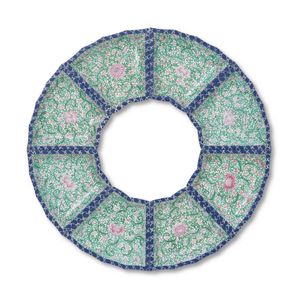Enamel-decorated Yixing Zisha Sweetmeat Dish Set
A Chinese Yixing Zisha sweetmeat dish set, Qing Dynasty (1644-1912), 19th century, comprising eight shaped dishes of deep purple clay with enamel decoration of scroling peonies to the interior, and cracked ice on a blue ground to the rim. Each 2.5 cm high, 16 cm wide
You must be a subscriber, and be logged in to view price and dealer details.
Subscribe Now to view actual auction price for this item
When you subscribe, you have the option of setting the currency in which to display prices to $Au, $US, $NZ or Stg.
This item has been sold, and the description, image and price are for reference purposes only.
- Qing Dynasty - The Qing Dynasty was the last imperial dynasty of China, ruling from 1644 to 1912. It was established by the Manchu people, who originated from the northeastern region of China. The Qing Dynasty was preceded by the Ming Dynasty and followed by the Republic of China.
- Chinese Cracked Ice Motif - The Chinese cracked ice decorative motif is a traditional design that was commonly used in Chinese art and architecture, particularly in the Ming and Qing dynasties (1368-1912). The motif is characterized by a pattern of small, irregular cracks or fissures that resemble broken ice.
The cracked ice motif was often used in a variety of decorative arts, such as pottery, porcelain, lacquerware, and furniture. It was also used in architectural elements, such as floor tiles, roof tiles, and wall panels. The motif was typically created by carving or incising the surface of the material, and then filling the cracks with a contrasting color, such as black or gold.
The cracked ice motif symbolizes the idea of "coolness" in Chinese culture, and was often used in architectural elements to create a sense of coolness and shade, especially in hot climates. In decorative arts, it is considered as an elegant and refined design that evokes the natural beauty of ice. - Ming Dynasty - The Ming Dynasty was a ruling dynasty of China from 1368 to 1644. It succeeded the Yuan Dynasty and preceded the Qing Dynasty. The Ming Dynasty was established by Zhu Yuanzhang, a former Buddhist monk who became a rebel leader and eventually overthrew the Mongol Yuan Dynasty. During the Ming Dynasty, China experienced a period of relative stability and prosperity. The government was centralized and bureaucratic, with the emperor at the top of the hierarchy. The Ming Dynasty is known for its cultural achievements, including the development of porcelain, the invention of movable type printing, and the construction of the Great Wall of China.
This item has been included into following indexes:
